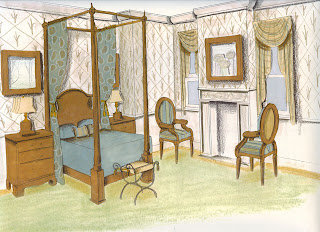I LOVE COLOR
One of the great things about art and designing is color. You can use it in splotches, large areas, as patterns, as accents, or as a whole theme. Color has a way of setting the mood of the room or artwork.
 |
| Dark Mood (click for website) |
At first glance, a piece of artwork can produce a feeling inside the viewer, based solely on the colors used. When looking at a dark painting, one with lots of blacks, grays, deep blues etc, you are immediately left feeling dismal or gloomy. Expecting to see dark forces at work in the piece. However, when you view a painting with bright yellows, reds, oranges, whites etc, you immediately feel brighter, happier, sunnier. The tone has been set and the artist will use those colors for that specific purpose. Furthermore, a death or funeral scene will not seem so dark and depressing if painted with those brighter colors.
 |
| Light Mood (click for website) |
Now for our basic art lesson for the day. The color wheel is made up of 3 primary colors, 3 secondary colors and 6 tertiary colors. The primary colors are red, blue and yellow. Any color found in the rainbow can be created by using these three colors, and these colors can not be produced by mixing any other colors together. The secondary colors are orange (red + yellow), purple (red + blue) and green (yellow + blue). The tertiary colors are created by mixing a primary with a secondary; yellow-green, red-orange, etc.
As a little side note - the red blue yellow color wheel is not entirely correct. It is the artists' color wheel. In actuality the true primary colors are yellow, magenta and cyan. Most people recognize these from your color printers. However, most art students are taught the ROYGBV color wheel. To see an explanation of what I mean check out this website:
Color Theory. (Image below from this website as well)
Study the color wheel for a moment and take the time to see which colors are opposite each other. These colors are complimentary colors and have many uses. The complimentary color can be added to create shadows. For example, when in my high school art class (I use this example because it is most vivid in my mind), I was working on a color still life. One of the pieces in my section included an orange bottle. In order to show the shadows, I used blue. The result was near perfection. I say near because I was in high school and still learning many many things about color and art. The complimentary colors are red-green, yellow-purple, and blue-orange.
A relatively common myth is that black is the lack of color and white is all colors. This is wrong. Black absorbs all the colors, while white reflects them. So I guess, it would depend on the way you look at it. Black could be the absence of color since you don't perceive any while you are actually seeing all the colors reflected from the white. Either way you view it, both are colors. Furthermore, both can me mixed with the primary and secondary colors to get desired shades, or hues, of color.
Check out these vivid colors and tell me that you love color too!



















